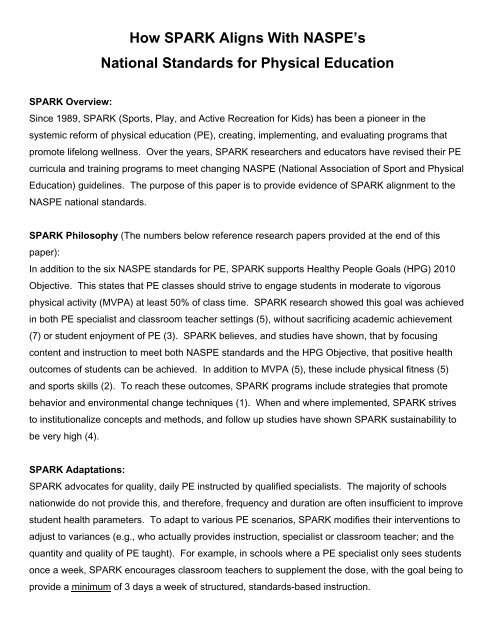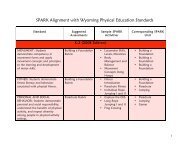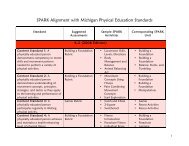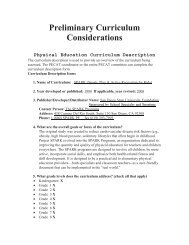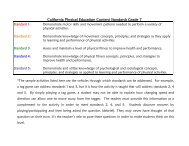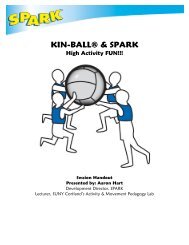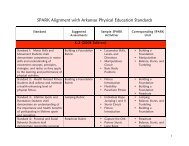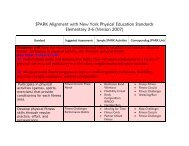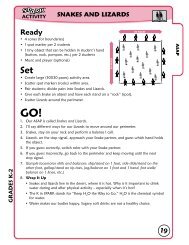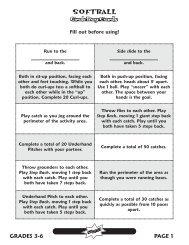National (NASPE, National Association of Sport and Physical ...
National (NASPE, National Association of Sport and Physical ...
National (NASPE, National Association of Sport and Physical ...
Create successful ePaper yourself
Turn your PDF publications into a flip-book with our unique Google optimized e-Paper software.
<strong>NASPE</strong> St<strong>and</strong>ards for <strong>Physical</strong> Education<strong>Physical</strong> activity is critical to the development <strong>and</strong> maintenance <strong>of</strong> good health. The goal<strong>of</strong> physical education is to develop physically educated individuals who have theknowledge, skills, <strong>and</strong> confidence to enjoy a lifetime <strong>of</strong> healthful physical activity.A physically educated person:St<strong>and</strong>ard 1: Demonstrates competency in motor skills <strong>and</strong> movement patterns neededto perform a variety <strong>of</strong> physical activities.St<strong>and</strong>ard 2: Demonstrates underst<strong>and</strong>ing <strong>of</strong> movement concepts, principles, strategies,<strong>and</strong> tactics as they apply to the learning <strong>and</strong> performance <strong>of</strong> physical activities.St<strong>and</strong>ard 3: Participates regularly in physical activity.St<strong>and</strong>ard 4: Achieves <strong>and</strong> maintains a health-enhancing level <strong>of</strong> physical fitness.St<strong>and</strong>ard 5: Exhibits responsible personal <strong>and</strong> social behavior that respects self <strong>and</strong>others in physical activity settings.St<strong>and</strong>ard 6: Values physical activity for health, enjoyment, challenge, self-expression,<strong>and</strong>/or social interaction.
SPARK Compliance to <strong>NASPE</strong> St<strong>and</strong>ards<strong>NASPE</strong> St<strong>and</strong>ard1. Demonstrates competency in motor skills<strong>and</strong> movement patterns needed toperform a variety <strong>of</strong> physical activities.2. Demonstrates underst<strong>and</strong>ing <strong>of</strong>movement concepts, principles,strategies, <strong>and</strong> tactics as they apply tothe learning <strong>and</strong> performance <strong>of</strong> physicalactivities.SPARK AlignmentSPARK content (lesson plans provided in scope <strong>and</strong>sequence) <strong>and</strong> training sessions (workshopsconducted at school sites) present many movementactivities to meet this st<strong>and</strong>ard as well as thenecessary pedagogical skills. Additionally, via bothSPARK content <strong>and</strong> targeted h<strong>and</strong>outs atworkshops, SPARK assessment tools demonstratestudent achievement <strong>of</strong> competency <strong>and</strong>/orimprovement in St<strong>and</strong>ard 1. Additionally, SPARK’scommitment to MVPA, fitness <strong>and</strong> skills (papersdemonstrate significant student achievement in allthree) further support alignment with this goal.SPARK content (lesson plans provided in scope <strong>and</strong>sequence) <strong>and</strong> training sessions (workshopsconducted at school sites) present many movementactivities to meet this st<strong>and</strong>ard as well as thenecessary pedagogical skills. Additionally, via bothSPARK content <strong>and</strong> targeted h<strong>and</strong>outs atworkshops, SPARK assessment tools demonstratestudent achievement <strong>of</strong> competency <strong>and</strong>/orimprovement in St<strong>and</strong>ard 1. Additionally, SPARK’scommitment to MVPA, fitness <strong>and</strong> skills (papersdemonstrate significant student achievement in allthree) further support alignment with this goal.3. Participates regularly in physical activity. During PE:SPARK advocates for quality, daily, physicaleducation. SPARK has been proven to increasemoderate to vigorous physical activity (MVPA) toabove 50% during PE classes in both specialist <strong>and</strong>generalist settings. SPARK content <strong>and</strong> instructionare designed to provide all children maximumopportunities to participate <strong>and</strong> practice skills <strong>and</strong>engage in health-related fitness activities.
<strong>NASPE</strong> St<strong>and</strong>ardSPARK AlignmentOutside <strong>of</strong> PE class:SPARK encourages environmental change thatpromotes PA throughout the school day (e.g.,before <strong>and</strong> after school programs, recess <strong>and</strong> lunchbreaks, integration with core subjects <strong>and</strong> PA in theclassroom). SPARK works with teachers toenhance their PE content to include more lifetimeactivities (e.g., Frisbee, golf, yoga, etc.), as well asmovement opportunities that generalize to thecommunity (e.g., kayaking in Alaska, surfing inSouthern CA, lacrosse in New Engl<strong>and</strong>, etc.).Additionally, SPARK teachers are trained toencourage regular physical activity outside <strong>of</strong> PEthrough promotional techniques (e.g., teachers askstudents what activities they have participated inover the weekend, if anyone walked to school, orhow they are doing with their PAL (physical activitylogs) that monitor movement outside <strong>of</strong> PE class<strong>and</strong> <strong>of</strong>fer PA goal-setting opportunities).The SPARK Lifelong Wellness (LW) program hasbeen developed for elementary physical educationspecialists, classroom teachers, <strong>and</strong> after schoolprogram leaders <strong>and</strong> has also been used effectivelyin middle school environments. SPARK LW isdesigned to teach children <strong>and</strong> adolescents theskills necessary to be active outside <strong>of</strong> physicaleducation class, on the weekends, during vacations,<strong>and</strong> ultimately the rest <strong>of</strong> their lives. Additionally,students learn how to make healthy food choices,reduce time playing video games <strong>and</strong> watchingtelevision (low-voltage activities). Behavior changecomponents are woven throughout the LW program<strong>and</strong> include goal setting, rewards, scheduling timefor activity, obtaining social support, scheduling <strong>and</strong>planning skills, environmental stimulus, <strong>and</strong> positiveself-talk.
4. Achieves <strong>and</strong> maintains a healthenhancinglevel <strong>of</strong> physical fitness.5. Exhibits responsible personal <strong>and</strong> socialbehavior that respects self <strong>and</strong> others inphysical activity settings.6. Values physical activity for health,enjoyment, challenge, self-expressions<strong>and</strong>/or social interaction.SPARK promotes physical fitness in almost everylesson <strong>and</strong> in grades 3-8, SPARK provides aPersonal Best Day (PBD) fitness test. This teachesstudents how to monitor their fitness progress overtime, <strong>and</strong> administers three objective fitness tests.Additionally, PBD prepares students systematicallyfor fitness testing via use <strong>of</strong> the Fitnessgram,<strong>Physical</strong> Best, or Presidential programs. SPARKoutcomes show measurable <strong>and</strong> significantimprovement in fitness parameters – compared tonon-SPARK trained teachers’ students.The SPARK LW program was shown to be effectivein increasing the number <strong>of</strong> minutes students areactive outside <strong>of</strong> PE class, <strong>and</strong> anecdotally,teachers <strong>and</strong> parents reported increases in theirown personal activity programs.SPARK includes the teaching <strong>of</strong> social skills in allprograms <strong>and</strong> reinforces this during teachertraining opportunities. Utilizing a t-chart, SPARKtrained teachers learn how to facilitate discussion<strong>of</strong> the social skill, solicit student responses on whatthat skills looks like <strong>and</strong> sounds like, <strong>and</strong> how toassess student compliance during class. BecauseSPARK emphasizes inclusion <strong>and</strong> spendssignificant time during workshops on studentempowerment techniques <strong>and</strong> graduateddifferentiated learning, the learning environmentfosters self-confidence, positive self-image, <strong>and</strong>self-esteem in every child. The no or lowcompetitivenature <strong>of</strong> SPARK strives to provide anequal opportunity for physical activity for everychild, regardless <strong>of</strong> skill level. Facilitating individualstudent success everyday enhances one’spersonal skills <strong>and</strong> enjoyment <strong>of</strong> PE, <strong>and</strong> thusencourages repeating movement experiencesoutside <strong>of</strong> class.Via student surveys, it was demonstrated thatSPARK activities were enjoyed by students, <strong>and</strong>over the years, SPARK continues to edit <strong>and</strong>enhance content with student enjoyment in mind.Challenge is a large part <strong>of</strong> SPARK pedagogy, <strong>and</strong>in teacher training opportunities, a concerted effortis made to move teachers from direct <strong>and</strong> comm<strong>and</strong>style to using inclusionary techniques <strong>and</strong>empowering students via greater student centeredlearning strategies. Presenting activities with achallenge <strong>and</strong> a question instead <strong>of</strong> a m<strong>and</strong>ate is aSPARK pedagogy trademark. Partner <strong>and</strong> group
activities, many <strong>of</strong> which are cooperative, creative,<strong>and</strong> problem-solving in nature, serve to foster selfexpression<strong>and</strong> positive social interactions duringclass.Additionally, the Lifelong Wellness programreinforces these concepts <strong>and</strong> provides activitiesthat address them in a classroom setting <strong>and</strong>/orduring inclement weather days where activityopportunities may be limited.Cited references:1. Marcoux, M.F., Sallis, J. F., McKenzie, T. L., Marshall, S., Armstrong, C. A., & Goggin, K. (1999).Process evaluation <strong>of</strong> a physical activity self-management program for children: SPARK. Psychology <strong>and</strong>Health, 14, 659-677.2. McKenzie, T. L., Alcaraz, J. E., Sallis, J. F., & Faucette, F. N. (1998). Effects <strong>of</strong> a physical educationprogram on children's manipulative skills. Journal <strong>of</strong> Teaching in <strong>Physical</strong> Education, 17, 327-341.3. McKenzie, T. L., Alcaraz, J., & Sallis, J. F. (1994) Assessing children's liking for activity units in anelementary school physical education curriculum. Journal <strong>of</strong> Teaching in <strong>Physical</strong> Education, 13, 206-215.4. McKenzie, T. L., Sallis, J. F., Kolody, B., & Faucette, N. (1997). Long term effects <strong>of</strong> a physicaleducation curriculum <strong>and</strong> staff development program: SPARK. Research Quarterly for Exercise <strong>and</strong> <strong>Sport</strong>,68, 280-291.5. Sallis, J. F., McKenzie, T. L., Alcaraz, J. E., Kolody, B., Faucette, N., & Hovell, M. F. (1997). The effects<strong>of</strong> a 2-year physical education program (SPARK) on physical activity <strong>and</strong> fitness in elementary schoolstudents. American Journal <strong>of</strong> Public Health, 87, 1328-1334.6. Sallis, J. F., McKenzie, T. L., Kolody, B., Lewis, M., Marshall, S., & Rosengard, P. (1999). Effects <strong>of</strong>health-related physical education on academic achievement: Project SPARK. Research Quarterly forExercise <strong>and</strong> <strong>Sport</strong>, 70, 127-134.


